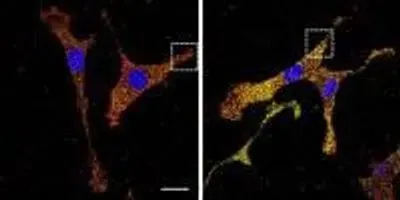 Researchers use fluorescence probes to monitor increases in mRNA-ribosome interaction levels for a gene associated with iron storage in response to iron (right panels). Scale bar = 20 μm.Image Credit: American Chemical SocietyThink of life as a house: if DNA molecules are blueprints, then messenger RNAs (mRNAs) are orders, describing the required parts (proteins) and when they should arrive. But putting in many orders doesn't always mean you'll get all of the parts on time -- maybe there's a delay with your vendor or delivery service. Similarly, mRNA levels alone do not dictate protein levels. In ACS Central Science, researchers report a method to address that issue.
Researchers use fluorescence probes to monitor increases in mRNA-ribosome interaction levels for a gene associated with iron storage in response to iron (right panels). Scale bar = 20 μm.Image Credit: American Chemical SocietyThink of life as a house: if DNA molecules are blueprints, then messenger RNAs (mRNAs) are orders, describing the required parts (proteins) and when they should arrive. But putting in many orders doesn't always mean you'll get all of the parts on time -- maybe there's a delay with your vendor or delivery service. Similarly, mRNA levels alone do not dictate protein levels. In ACS Central Science, researchers report a method to address that issue.
David Tirrell, Kelly Burke and Katie Antilla note that in order to better understand how genes are regulated, one needs to see the mRNA when it is at the site of protein synthesis. Using fluorescence probes, the researchers designed a technique that shows mRNA when it comes in contact with giant protein synthesizing machines called ribosomes. They used this method to record the synthesis of proteins and to measure cellular responses to iron. Unlike previous methods, their tool works without the need to engineer an mRNA of interest. Tirrell notes that the method is applicable to essentially any type of RNA, and could be modified to visualize other types of interactions in the cell.










